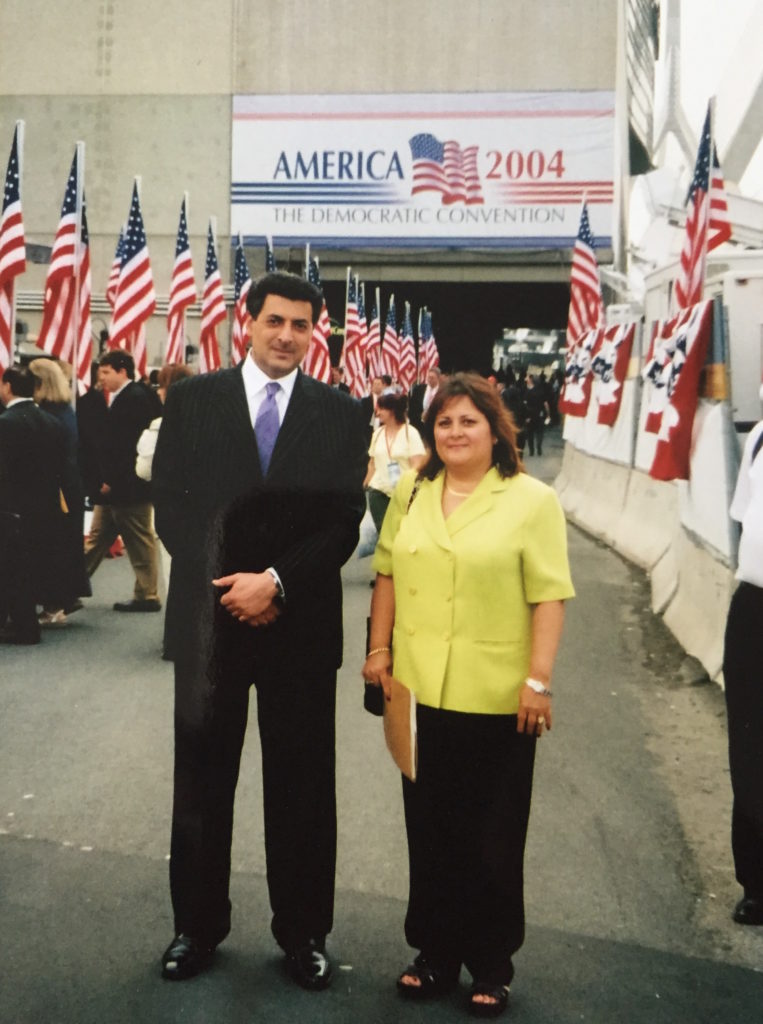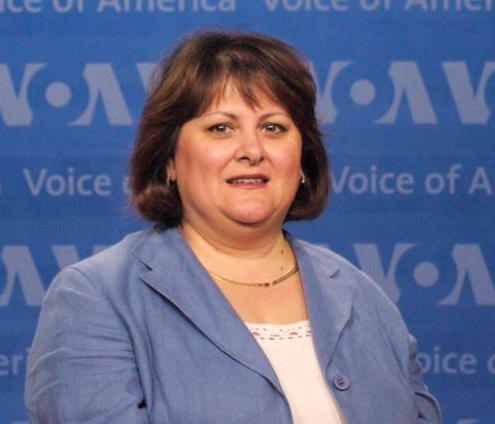Although I have spent the last 45 years in the United States, I consider myself more of a citizen of the world.
For thirty years, I was a journalist. I learned to explore and explain everything around me, ranging from political developments to everyday matters. But in 2015, after 30 years at the Voice of America, I decided it was time to retire.
VOA is part of the U.S. Agency for Global Media, the government agency that oversees all non-military, U.S. international broadcasting. It is funded by the U.S. Congress.
My years at VOA were some of the most interesting and productive of my life. I witnessed many changes in the world and in broadcasting. I didn’t just watch history unfold; I told it as it was unfolding. And as a result, I played a part in changing it.

When I joined the Armenian Service in June of 1980, Armenia was still part of the Soviet Union. People in the office were still using manual typewriters to report the news.
Broadcasts in Armenian had started nearly three decades earlier in 1951. Up until that point, all broadcasting was done in Russian and Ukrainian, the languages of the two major political entities. At that time, Moscow interpreted our broadcasting as an openly hostile act, reflecting a foreign policy aimed at the eventual dismemberment of the Soviet Union.
And they weren’t entirely wrong. According to Edward Alexander, the first Armenian Service Chief, the use of these languages “was a direct channel to peoples of Soviet Union for information about the United States, to counteract the [USSR’s] distorted propaganda.”
The first Armenian-language broadcasts consisted of a one-hour radio program. The first 10 minutes covered international news, followed by short four to five minute backgrounders and analytical features about current events, Armenia and other neighboring countries. The last half hour usually consisted of features about life in America, reports on Armenian community events and interviews with Armenian-Americans. The daily one-hour daily radio show always ended with a five-minute news summary.
I didn’t just watch history unfold; I told it as it was unfolding.
Shortly after, electric typewriters were introduced, followed by computers with custom made Armenian font. VOA had just started using tapes for recording (before that they were recording on huge plastic disks.)
My first 10 years at the Armenian Service were extremely interesting. I polished skills in writing radio pieces, conducting interviews, and hosting live radio programs. I also occasionally traveled around the country to cover events in the Armenian community and historic American celebrations, such as the 100th anniversary of the Statue of Liberty in New York in 1986.
During President Reagan’s administration, public diplomacy became more important, and the Soviet bloc language services began to receive more resources to enrich programming. A 15-minute, live breakfast show was added to the existing one-hour live evening radio show. At the time, Soviet government officials in Armenia were jamming all radio programs (Beginning in 1948, as part of efforts to censor information and political news from outside the iron curtain, the USSR made frequent use of radio jamming from VOA and other western radio programs, including BBC.)
Years later, in 1993, after the independence of Armenia was established, I visited Armenia and I met one such person—whose job during the Soviet years was to jam the very programs I had toiled to air.

Nevertheless, local audiences managed to follow our programs, and VOA’s popularity grew tremendously throughout the eighties. The programs were broadcast on several short and medium wave frequencies, and listeners switched from one to another to avoid the jamming. As the host of the one-hour radio show, I had to repeat the list of radio frequencies in our broadcasts, at least twice, at the beginning and ending of the show.
I especially enjoyed writing special radio features about life in America, American music, and new developments in science and medicine. Another memorable trip was to Nashville, Tennessee, the music capital of the country. A group of our music programmers met with songwriters and famous American musicians and performers and reported about the music industry, which, at that time, was considered America’s biggest export industry.
In 1985, the Politburo of the USSR Communist Party Central Committee elected Mikhail Gorbachev as its new General Secretary. This event initiated the internal transformation of the Soviet Union and at the end of the eighties, under Gorbachev’s “glasnost” and “perestroika” movements, Armenia began to move away from Moscow (though Moscow’s suppression of the Armenian democratic movement continued in less obvious ways, avoiding any action that would trigger mass revolt in Armenia). During this period, the VOA Armenian Service was crucial in providing information to the country.
In 1987, one of the leaders of the democratic movement, Paruir Hairikyan, was stripped of Soviet citizenship and exiled to Ethiopia following his accusations that the Soviet leadership had instigated the Sumgait Pogroms of the Armenian population in Azerbaijan. From Ethiopia, Mr. Hairikyan contacted the VOA Armenian Service, and we ran an interview with him, where he described how the Russian KGB had secretly arrested him after he met with officials from the U.S. Embassy in Moscow. I had the privilege of interviewing him.
After this, the independence movement finally gained wider support, and Armenia finally declared its independence in 1991. I covered the young republic’s first democratic presidential elections, interviewing all the candidates.
Years later, in 1993, after the independence of Armenia was established, I visited Armenia and I met one such person—whose job during the Soviet years was to jam the very programs I had toiled to air.
One of the most heartbreaking moments of my career was the devastating Spitak earthquake in December of 1988, killing almost 20,000 people. The natural disaster cut off all communication between Armenia and outside, but the Voice of America’s shortwave broadcasting was still sending reports oversees from the U.S. During this time, it was the only way people in Armenia could learn about their own situation and, in particular, about outside efforts to help them.
At one point following the earthquake, a priest from an Armenian church in Washington contacted me at VOA to ask if I could interview him about a plane shipment of relief equipment that was being sent to Armenia, donated by the Diaspora. The broadcast would be the only medium through which he could communicate with people on the ground in Armenia. He hoped that the Armenian Catholicos, the supreme leader of the church, might get the message and distribute the resources to people in need.
We did the interview, during which he announced the exact date and time when the plane was scheduled to land in Armenia. Indeed, the Catholicos of Armenia, who was a loyal VOA program follower, came to the airport to receive the aid, which otherwise would have fallen into the hands of corrupt officials, in which case it is likely the materials would never have made it into the hands of the people, who desperately needed the help.
From 1988 to 1992, we put a great emphasis on radio programming to help Armenia on the road to peace and democracy; we produced a radio series on democracy, democratic institutions, women’s issues, and developments in science, medicine, business, and the environment. Then, in 1992, my husband was transferred to Saudi Arabia for work. I took a five-year hiatus from my role at VOA to accompany him with our two small children, though I periodically sent in freelance articles from the Middle East. In 1998, I returned to the U.S. and also, to VOA’s Armenian Service, but this time, as Service Chief.

We continued building on past accomplishments and innovating, but in 2004, we faced a major challenge. Due to budget cuts, VOA announced that the Bulgarian, Estonian, Czech, Hungarian, Latvian, Lithuanian, Polish, Romanian, Slovak, and Slovenian language services would end their regularly scheduled programs. Although the Armenian language radio program was not eliminated, it suffered severe cuts and was directed to use the remaining resources to maximize its impact in post-Soviet Armenia, the target region.
Several Armenian TV executives, who had visited VOA Armenian Service during a U.S. State Department-hosted tour to learn about free press practices in the U.S., were eager to partner with VOA. Out of these, VOA chose Armenia TV, the second major TV station in Armenia after the state sponsored Public TV. Armenia TV was more Western-oriented than other television outlets in the country at that time, likely in no small part because it was financially supported by a U.S. Armenian businessman and philanthropist, Gerard Cafesjian. They used cutting edge technology to broadcast programs that reached not only the whole country, but also Diaspora communities around the world, including the Middle East and the U.S. In May of 2004, VOA Marketing offered and signed its first affiliate contract with Armenia TV Company.
For the last 11 years, the Armenian Service has continued to produce two VOA Armenian programs: Armenian Daily Report, which airs, Monday-Friday, consisting of 10-minute news and a feature program; and Armenian TV Magazine, a 20-minute standalone program that includes feature stories and interviews about Armenian Diaspora life and other Armenia related events in the Washington, D.C area. These programs are fed to ARMENIAN TV every day for broadcasting within their network.In addition, the Armenian Service has web and mobile sites, and is available on Facebook, Twitter and YouTube.
With very limited resources, the Service is able to maintain high quality TV programming for the target area. According to a Gallup survey, the Armenian Service accounts for most of Armenia’s U.S. international media audience, with a total weekly audience reach of 33.7 percent.
During my television coverage of the 2004 U.S. presidential elections, I met with an Armenian presidential candidate at an election party convention in Boston. Stephan Demirchian was part of a visiting group made of presidential candidates from former Soviet republics. The visit was sponsored by a U.S. NGO to exemplify political freedom in presidential elections. Mr. Demirchian was most impressed with how the opposition party candidate campaigned freely in the US, and how the voters were allowed to cheer for their candidate and criticize the government in power. During our conversation, he seemed sad, and at one point, he told me it would take many years to establish this kind of freedom in Armenia.
It seems those many years have passed—and that day has come. I am proud of Armenia’s citizens for standing up to corruption and achieving a peaceful revolution. I am proud of Armenia’s press for unwaveringly reporting news about the historic demonstrations to the Diaspora and the rest of the world. Much has changed since I began reporting on Armenia’s current affairs nearly three decades ago; much, it seems, for the better.
Note from the Editors: Araxie Vann, née Kazandjian, began her career in journalism in the seventies at the Hairenik and Armenian Weekly offices, back when they were located in Copley Square (not Watertown, as they are today). She worked for the Hairenik newspaper, the Armenian-language counterpart to the Weekly, as a translator, where she translated texts from Eastern Armenian and English into Western Armenian, before embarking on her VOA career at the State Department. For full disclosure, nearly fifty years later, her daughter is an editor at the English-language counterpart to that very newspaper. It speaks to the generational role that these newspapers have played in the Armenian community, that the Armenian and Hairenik Weekly newspapers continue to offer stepping stones into the world of journalism to current and future generations of Diasporans.
Author information
The post Thirty Years in Armenian Journalism appeared first on The Armenian Weekly.
Source: Armenian Weekly
Link: Thirty Years in Armenian Journalism

